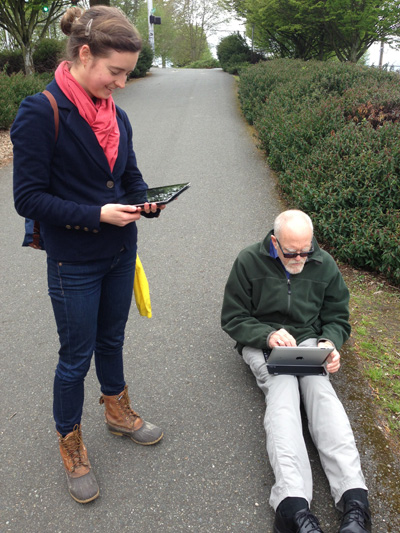In the last three weeks I've flown to Miami twice, each time for the Community Health Maps (CHM) project. This is a project I've been working on for years. The goal is to empower underserved populations with low cost, intuitive mapping tools. The work is funded by the National Library of Medicine.
I went to Miami specifically to support an already established coalition of organizations working to document the impacts of king tides and help the communities being impacted. The focus was on one particular community, Shorecrest, who's residents are feeling the effects twice a day. "King tide" is basically a popular term for the highest tides of the year. It is sea level rise in action. The groups involved include: New Florida Majority, Florida International University, Resilient Miami, and Unitarian Universalist Justice Florida.
We had been planning these two trips since summer to coincide with the September and October king tides. The plan was to support the community by training them in how to map these king tide events and their impacts. Then Hurricane Irma hit. I wasn't sure what to expect. Would it be more useful to help people document the effects Irma had on their neighborhoods? Would people even have time to deal with the king tides in the aftermath of Irma?
When I first landed on September 17th it had only been six days since Irma had blown through. On the surface things looked almost normal. There was very obvious little structural damage. The visible damage from the street was piles of brush and debris on everyone's curb. The hotel was full of relief workers, mostly tree trimmers. Packing for these workshops were also a little different. I expected the water to be polluted, and it was also hard to know what the power situation would be in the neighborhoods I would be visiting. So I brought rubber boots, gloves, a face mask, portable chargers and a water purifier.
We ended up going ahead with the initial plan. Collectively it was decided that there are often numerous variables involved in king tides such as storms. So the data would still be useful and it would be good practice for the community. Plus we might learn if there was more bacterial contamination resulting from the hurricane.
I thought this effort would be a perfect use of the new Fulcrum Community accounts. So Susan Jacobson from FIU applied for an account. It was immediately granted and we ended up using that. Jacobson and Tiffany Troxler from FIU, and Jan Booher from UU had already developed a water sampling protocol. They had refractometers for measuring salinity and bottles for collecting water samples. The bottles had a reagent in them that would tell us whether the samples were infected with bacteria such as coliform. They also had yard sticks for measuring flood depth.
A King tide data collection kit
Two days ago I returned from the second trip to Shorecrest. Over the two trips I conducted several workshops with: people living in Shorecrest, students at FIU and community leaders. Using Fulcrum Community allowed me to focus on data collection with the community members. The only tech piece involved showing them how to use the Fulcrum app on their phones. That allowed our team to spend more time teaching about the actual water sampling protocol. Following that I taught a more involved workshop to the community leaders. There I showed how to manage the data and map it via QGIS and Carto. Going forward it will be their project to manage and I'll just serve in a support role. On October 7th there were dozens of people out collecting data!
Residents mapping and sampling King tides
The interesting thing about King tides is that they can come up via storm drains. The Shorecrest neighborhood we worked in is close to the coast, but not right on the coast. However, it is in a particularly low lying portion of Miami. During these king tides water comes up through these storm grates two times a day, flooding the streets, driveways and yards up to 2-3 feet in depth. The water is saline and initial water samples show that most has some level of bacterial contamination. The video below shows the flooding on October 7th at the intersection of NE 78th & 10th streets.
Recently there have been some heavy rains saturating the soil and creating minor flooding in low lying areas. On October 7th the twice daily tidal flooding just added to it. The king tide water came up through the storm drains, cracks in the asphalt and the ground. The water rose up to knee level in a little over an hour. It flooded the Little River Pocket Park, streets, peoples driveways and yards. Trash piles from Irma are still there and are now potential sources of bacterial pollution. Most residents are also still dealing with mold and flood damage from Irma. It is not a good situation. Below are some before and afters that show the situation:
Little River Pocket Park - before
Little River Pocket Park - during king tide
Before...
During king tide
Before...
During king tide
It was really powerful to be dropped into this community of Shorecrest, meet real people with real problems, and be able to help in some small way. My goal has always been to use the technology to help make the world a better place. I've also always been an activist. This work felt good from both perspectives. Disasters always affect poor areas the most and this is no different. It's a pretty grim situation that isn't getting much press. I'll be following up with some results in the near future, building on the initial map below.















